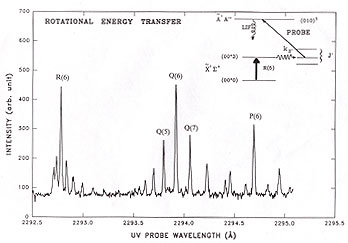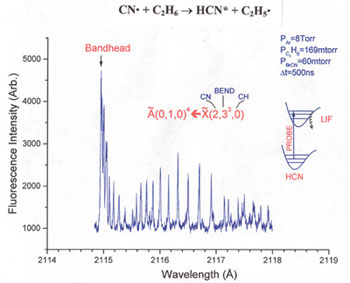Faculty Profile
 Edwin Carrasquillo M
Edwin Carrasquillo M
Professor
Department of Chemistry
Office: Fleming, 139G
Contact: mcarrasquillo@uh.edu - 713-743-3230
Education: Ph.D., University of Chicago, 1984; B.S., University of Chicago, 1977
Research Associate, University of Wisconsin, Madison, 1984-1987
Our research explores laser spectroscopy, molecular dynamics and chemical reactivity with special focus on quantum state-selective studies of polyatomic molecules at high levels of vibrational excitation. Even though it is at high vibrational energy content that much of chemistry takes place, molecular behaviour in this regime is poorly understood. This is in large part due to the experimental difficulty of state-selectively preparing or detecting highly vibra-tionally energized polyatomic molecules. We have demonstrated that the combination of single photon overtone vibration excitation, to directly prepare the energized species, with a laser induced fluorescence probe can successfully resolve the rotational and vibrational state-to-state collision dynamics of highly excited polyatomic molecules. Such state-resolved studies are essential for extracting the elemental, but previously inaccessible, physical interactions governing the transfer of energy during the collision event. We are now implementing the overtone excitation approach on HCN and other model systems in an effort to uncover the systematic features of collisional relaxation at high vibrational excitation.
 Another important area of interest to our group consists of the spectroscopy of these
energetic molecules. Modelling molecules at high vibrational energy content carries
both fundamental and practical significance. However, the higher density of states
and the prevalence of intramolecular mode mixing makes characterization of the energized
species inherently more complex and much less developed than at low internal excitation.
Currently, we are implementing and developing laser double resonance methods to unravel
the spectroscopy of highly excited molecules. Those studies are also being extended
to probe chemical reactivity. For instance, exothermic reactions usually produce polyatomic
molecules. These molecules are almost invariably highly vibrationally excited.
Another important area of interest to our group consists of the spectroscopy of these
energetic molecules. Modelling molecules at high vibrational energy content carries
both fundamental and practical significance. However, the higher density of states
and the prevalence of intramolecular mode mixing makes characterization of the energized
species inherently more complex and much less developed than at low internal excitation.
Currently, we are implementing and developing laser double resonance methods to unravel
the spectroscopy of highly excited molecules. Those studies are also being extended
to probe chemical reactivity. For instance, exothermic reactions usually produce polyatomic
molecules. These molecules are almost invariably highly vibrationally excited.  Because of the difficulty in detecting energized polyatomic species, studies which
state-selectively probe the products are very rare. This greatly limits the knowledge
of the energy disposal and reaction mechanism that can be derived for such reactions.
Our previous spectroscopic studies have improved characterization of the ground and
excited electronic states of HCN (J. Mol. Spectrosc., 164, 416 (1994)) and have led to the development of sensitive laser induced fluorescence
detection techniques chart for the energized species.These detection capabilities
are now being applied to better investigate CN radical reactions and other important
types of reactions by state-resolution of the products.
Because of the difficulty in detecting energized polyatomic species, studies which
state-selectively probe the products are very rare. This greatly limits the knowledge
of the energy disposal and reaction mechanism that can be derived for such reactions.
Our previous spectroscopic studies have improved characterization of the ground and
excited electronic states of HCN (J. Mol. Spectrosc., 164, 416 (1994)) and have led to the development of sensitive laser induced fluorescence
detection techniques chart for the energized species.These detection capabilities
are now being applied to better investigate CN radical reactions and other important
types of reactions by state-resolution of the products.
Our laboratories are very well equipped with the present hardware consisting of two excimer pumped dye laser systems, an excimer laser for VUV operation utilizing ArF at 193 nm, or F2 at 157 nm, a YAG pumped dye laser system and a full array of Camac based data acquisition electronics.
- "Spectroscopy of HCN in the 6000 cm-1 Region," A. Saury, J. Wu, and Edwin Carrasquillo M., J. Mol. Spectrosc. 164, 416 (1994).
- "Direct Observation of Weak State Mixing in Highly Vibrationally Excited Acetylene," A.L. Utz, E. Carrasquillo M., J.D. Tobiason, F.F. Crim, Chem. Phys. 190, 311 (1995).
- "Self Assembled Monolayers Composed of Aromatic Thiols on Gold: Structural Caracterization and Thermal Stability in Solution," N. Garg, E. Carrasquillo-Molina, and T.R. Lee, Langmuir, submitted.
- "Collision-Assisted Spectroscopy Above the Barrier to Isomerization: HCN," D. Lessen, J.S. Baskin, C.M. Jones, T. He, and E. Carrasquillo-Molina, J. Chem. Phys., in preparation.